Welcome to the first installment of my New York Rangers prospect power rankings! This list will act the same way a team’s power ranking would, where every month I will give a short update about a player and they will be ranked on a combination of play, expectations, and of course my own bias. Goaltenders have not and will not be a part of these power rankings.
As the season started part way through the month of October, the first ranking doesn’t include just a single month as it usually would. Instead, I extended the schedule a bit to include the first week of November (7th) as well. I am excited to see how the players move around as we go further into the season, and I hope these rankings help you feel not only better connected to our prospect pool, but also more up to date as well.
1. Gabe Perreault, Boston College (6 GP: 5G, 5A)
In 6 games this season with Boston College, Gabe Perreault has 10 points. He hasn’t gone a single game without a point, producing 1.67 points per game and scoring the game-winning goal in BC’s last two games. The majority of his production has come at even strength and so far this season, he has looked stronger defensively than last season. His strong and consistent play landed him first in the Rangers prospect power rankings for the month of October.
2. Victor Mancini, New York Rangers (9 GP: 1G, 3A)
After a stellar rookie camp and an even more impressive training camp, a lot of people were surprised to see Victor Mancini make the Rangers opening night roster. So far this season, he has 4 points and we all know he should have more. He has played great for a player who made his professional debut about six months ago. He has plenty to work on, but has been a breath of fresh air for a team with a shallow defensive depth pool.
3. Noah Laba, Colorado College (3 gp: 1g, 5a)
After being given an “A” over the summer, he played well in Colorado College’s exhibition game and then put up 6 points in their first two games before being sidelined with a lower-body injury. It kept him out for a couple of games before he returned this past weekend. Unfortunately he seemed to have tweaked that same injury towards the end of his third game of the season, where despite his stellar face-off win percentage, he wasn’t able to show up on the scoresheet for the Tigers.
4. Brett Berard, Hartford Wolf Pack (10 GP: 5G, 3A)
The Wolf Pack are 10 games into the season and Berard once again leads the team in goals and is second on the team in points. While he is having a hot start scoring-wise, he has struggled a bit to stay consistent. He has gone the last 5 games without a point. It’s still very early in the season so I have no doubt his game will become more consistent as the season progresses.
5. Brennan Othmann, Hartford Wolf Pack (3 GP: 2G, 3A)
I struggled to make a decision on where to rank Othmann because he was injured in his third game of the season, but I didn’t think it was fair to rank him any lower than 5th because despite the lack of games, he was looking great to start the season. He currently sits at 5 points, which is good for a tie for 4th on the team in points, and that’s in seven fewer games than the player he is tied with.
Othmann looked stronger defensively and while people like to harp on him for being a power play merchant, the first PP unit has gone 0 for 26 in his absence. He will miss roughly 4-6 weeks with an upper-body injury. Hopefully when he returns, he continues to play the way he started the season.
6. Brody Lamb, University of Minnesota (8 GP: 5G, 4A)
Lamb has had an impressive start to this season for the Gophers; he has been noticeable for the right reasons almost every night. Not only has he improved his overall play, but he has been playing big minutes on the power play, where he has matched his point total from all of last year in just eight games this season. It is exciting to see his continued development on such a deep team.
7. Nathan Aspinall, Flint Firebirds (15 GP: 6G, 6A)
One of the Rangers’ newest draft picks caught everyone’s attention as another 6’7” forward added to their prospect pool. Aspinall has really surprised me this season; he has arguably been the Firebirds’ best player and that is without any of his production coming from special teams time. It will be interesting to see how he continues to develop; maybe on a better team in the future instead of on one of the bottom 5 teams in the OHL.
8. Adam Sýkora, Hartford Wolf Pack (10 GP: 2G, 3A)
Sýkora continues to make great strides in his development in a way that sometimes people seem to forget he is currently the youngest player on the Wolf Pack. His role last year was primarily on the checking line and on the penalty kill; he has for the most part done the same this year, but he looks more confident in that role this season.
I would like to see him be given some more chances to create offense, but he is great at what he does which is disrupting his opponents enough that they make mistakes that benefit him and the Wolf Pack.
9. Raoul Boilard, Baie-Comeau Drakkar (16 GP: 2G, 12A)
Despite his production so far this season, it seems Boilard is struggling to play a complete game. Most scouting reports from last season mention how strong he plays in all three zones, but so far this year he hasn’t shown the strong defensive tendencies he had last season. It is still too early in the season to really worry, but it is definitely something to keep an eye on going forward.
10. Ryder Korczak, Hartford Wolf Pack (10 GP: 1G, 2A)
Korczak is the player I struggled to rank the most; I wanted to rank him higher than I ultimately did because even though he doesn’t have the production some others do, he has been one of the steadiest players for the Wolf Pack so far this season. He has spent the majority of his time on ice in the bottom six and his penalty minutes are higher than in previous years, but he still plays well every night, including an outstanding overtime goal he scored last week.
11. Drew Fortescue, Boston College (6 GP: 1A)
Fortescue will never be a flashy defenseman, but he certainly is a steady one. This season he has once again been tasked with playing on the first defensive pairing and he has done a great job; his ability to stifle the other team’s offense makes him a very important player on the backend for the Eagles. As the season goes on, I hope to see him try to add a little more offense to his game, but there should be no complaints about his development so far.
12. EJ Emery, University of North Dakota (7 GP: 1A)
There isn’t a lot to say about Emery so far; he is playing well on a new team that is struggling overall. He has made some mistakes, but for the most part, he doesn’t tend to repeat them. He and his defensive partner have been the team’s best pair, so there are no worries about his defensive game at all. Just like Fortescue, I would like to see him add some offense to his game, though there is plenty of time for that moving forward.
13. Dylan Roobroeck, Hartford Wolf Pack (10 GP: 3G, 1A)
Roobroeck started the season a little slow, which was to be expected from a young player starting his first full professional season. In the last five games, he has looked very comfortable and has started to return to the way that he played for Oshawa last season: a menacing net-front presence. If he shows more consistency and gets stronger in the defensive zone throughout the rest of the season, he will move up the rankings quickly.
14. Jaroslav Chmelař, Hartford Wolf Pack (10 GP: 2G, 3A)
Production-wise, Chmelař has been okay; he is engaged at both ends of the ice and he controls play a lot, but he has really struggled in the Wolf Pack’s own zone. At times he doesn’t look as comfortable with the puck as he should, so I am unsure if he is struggling to adjust to head coach Potulny’s system, or if the top six role is something that doesn’t suit his play. I would like to see him get some more special teams time and be stuck in the defensive zone less as the season goes on.
15. Bryce McConnell-Barker, Hartford Wolf Pack (6 GP: 1G, 1A)
McConnell-Barker is lower down the rankings by no fault of his own; this season he has been in and out of the lineup, whether to fill in for injured players or to give guys a break. I think he would benefit from getting more consistent ice time and I think it would be smart to try to get him games at center. He is doing fine on the wing, but his slow adjustment may have to do with not playing his natural position, therefore I would like to see them give him some reps there soon.
16. Ty Henricks, Western Michigan University (4 GP: 1G, 1A)
While I haven’t been able to watch much of Henricks, I think he is playing well in what has for the most part been a fourth line role with the Broncos. He has been defensively sound, while also putting up some production in limited minutes. Hopefully he gets the chance to play up the lineup this season, but he is doing exactly what is asked of him right now.
17. Hank Kempf, Cornell University (2 GP: 1A)
Kempf plays for an Ivy League school, so unlike some other Rangers prospects who play college hockey, he has a lighter game schedule since these schools have restrictions on how long the season can be. We haven’t gotten to see him play much yet this year as a result of this. He has played well so far, but because of the lighter schedule, I didn’t think it was fair to rank him any higher. November should bring a more accurate ranking.
18. Matt Rempe, Hartford Wolf Pack (3 GP)
It would be careless for me to not mention that despite only playing three games with the Wolf Pack so far this season, Rempe has played three games with the Rangers as well. Unfortunately this season seems to be starting off as a struggle for the hulking forward. He played on the fourth line with New York and since returning to Hartford, he has struggled to adjust to the top six role they have given him.
The Wolf Pack may want him to play more minutes, but the role is not working for him and he would be better off playing in the bottom six with similar players — so far he has looked lost out there, and that is not fair to him.
19. Zakary Karpa, Harvard University (1 GP)
Karpa is in the same boat as Kempf where the lack of games as a result of playing for an Ivy League school made it difficult to accurately rank him. He had some struggles defensively last season, so I will be looking to see if that improves this year. As he is a senior, I am unsure if there is a spot for him in the organization once he graduates, unless he totally surprises them this season this could be our last look at him as a Rangers prospect.
20. Kalle Väisänen, Ilves (12 GP: 2G, 2A)
With the depth of the Wolf Pack, it was beneficial for Väisänen to be loaned back to Liiga and get a bigger role at home rather than be in and out of the lineup in the AHL. His issue is that while his offensive game seems to have gotten better, he is really struggling in his own zone, which isn’t a great sign. If he is going to find a role with the Wolf Pack, it would likely be in the bottom six, where being strong defensively has a lot of value.
Hopefully this is just the result of being on a new team, but it’s something to keep an eye on.
21. Rico Gredig, HC Davos (16 GP: 1G)
While I have been keeping up with Gredig on paper and staying updated on his play, it has been hard for me to actually watch him, so I had to put him near the bottom of my power ranking. Last week, he got a puck to the ear, but the good news is that he doesn’t seem to have suffered any serious injury or concussion from it. He is currently playing with the Swiss U20 team, where he had a goal in their overtime loss to Finland.
22. Rasmus Larsson, Northern Michigan University (7 GP)
Larsson unfortunately got dealt a bad hand; he is last on my power ranking and it mostly isn’t his fault. His team has been very bad overall, and the Rangers might be partially responsible for that. When it became clear that Grant Potulny, the Wolf Pack’s new head coach, was going to be leaving the team at the end of last season for an AHL opportunity, it led to not only players who played there last year leaving, but a lot of players decommitting as well.
This left Larsson as the only drafted player currently on the team, so while he is struggling in his transition to college hockey, it would be ridiculous not to mention that the team in general is as well, and it might be a while before they are comfortable together.


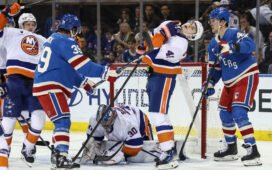
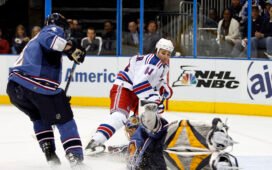
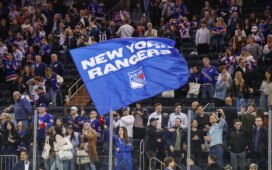
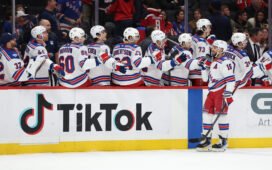
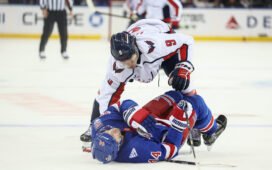

Recent Comments